2009-04-07 : 3 Resolution Systems
The cloud means the game's fictional stuff; the cubes mean its real-world stuff. If you can point to it on the table, pick it up and hand it to someone, erase it from a character sheet, it goes in the cubes. If you can't, if it exists only in your imagination and conversation, it goes in the cloud.
(If you remember this old post, you'll be like "where are the smiley faces?" They're looking down from above; they're the ones who enact the arrows. They were messing up the pictures' clarity.)
Resolution system #1 is for an imaginary game that's just like any game you might have played in 1990:
1 
"I take position on the crest of the hill."
"Okay."
"When he comes close, I attack him!"
2 
When your character attacks mine, roll dice.
3 
...And if your character has the high ground, add 2 to your roll.
4 
...And if you roll 10+, your character hits mine.
5 
...And you mark 2d6 hit points off my character sheet.
6 
...And if it's 8 or more hit points, your character knocks my character down.
Resolution system #2 is Dogs in the Vineyard's:
1 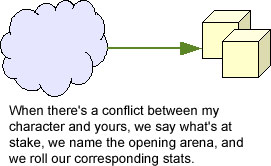
2 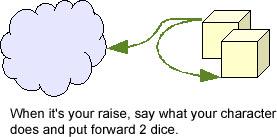
3 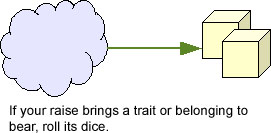
4 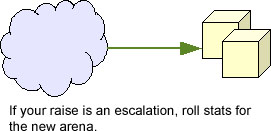
5 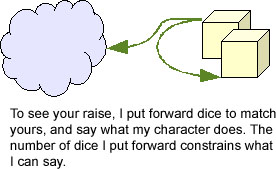
6 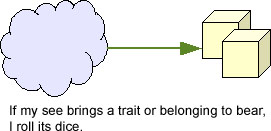
7 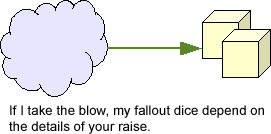
8 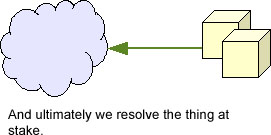
And resolution system #3 is for the Wicked Age:
1 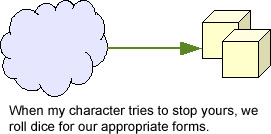
2 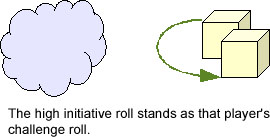
3 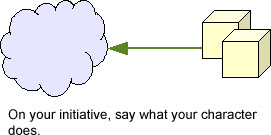
4 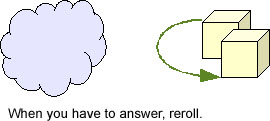
5 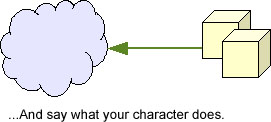
6 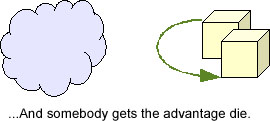
7 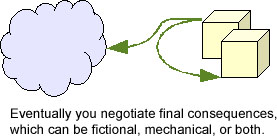
See what's missing from the Wicked Age? Rightward-pointing arrows.
1. On 2009-04-07, Vincent said:
Dogs in the Vineyard's rules ground play solidly in the immediate details of the game's fiction. In a Wicked Age's rules allow play to float above the game's fiction, more abstract.
Here's a related Forge thread: [Liquid] Well, I just rolled the dice for show. I don't really recommend that you go read it, though.
Oh, and: this isn't about the GM in old-school play yet, but it will be.
2. On 2009-04-07, majcher said:
It took me a couple re-readings there to figure out why you were specifically mentioning traits belonging to a bear in the Dogs diagram. Those bears, hard to just talk to them.
3. On 2009-04-07, Ryan Stoughton said:
"See what's missing from the Wicked Age? Rightward-pointing arrows." YES! I've been thinking about this since IAWA came out (and alternatively denying it and not being sure how to think about it). I'm just tickled that it's a topic.
4. On 2009-04-07, Vincent said:
Yep.
There are a couple of places in the game where there are supposed to be rightward-pointing arrows, but they're functionally optional. I assert them, but then the game's architecture doesn't make them real. So it takes an act of unrewarded, unrequired discipline to use them. I suspect that the people who have the most fun with the Wicked Age have that discipline as a practice or a habit, having learned it from other games.
5. On 2009-04-07, Vincent said:
I just this second finished listening to Rob and J talking about this, here: The Independent Insurgency #23: Ninja Master J on Human Contact.
Guys, you're talking about systematizing aesthetics, right? I strongly recommend that you look to the rightward-pointing arrow. Don't get fixated on the leftward-pointing one!
6. On 2009-04-07, Robert Bohl said:
It's certainly something to think about. I have to think of a way to do it healthily, as in Dogs escalation.
Where does this fit in?
It's (roll dice to see if I can make it true) oppressively hot. (System empowers me to do shit with "oppressively hot" so:) You're at -2 because it's oppressively hot.
Seems like it goes from boxes, to clouds, to boxes again.
7. On 2009-04-07, Ben Lehman said:
I have an issue with 2.2, 2.5, and 3.7
In particular, I don't think that what you've drawn is representing what actually happens in the game. I think that each of these is actually two steps, and it matters what order you take the steps in.
yrs—
—Ben
8. On 2009-04-07, Vincent said:
Ben: You're right.
9. On 2009-04-07, Guy Shalev said:
Vincent, an arrow from the cube that goes both to the cubes and to the bubble, does that count as rightward arrow for you?
Also, you said that those who have the most fun are those who insert these rightward arrows from elsewhere. If that is the most fun to play, why not include these arrows inside the game's mandatory structure?
10. On 2009-04-07, Vincent said:
Rob: It really depends.
Case 1:
1. When you want to describe the weather where the characters are, roll. On a success, say what the weather's like there. (On a failure, it's 76°, few clouds, with a pleasant little breeze.)
2. When your character's taking strenuous action, if it's oppressively hot where your character is, you get -2 to your roll.
That's boxes to cloud, then cloud to boxes.
Case 2:
1. When you want to give another player a die penalty, make a roll. On a success, a) say what's making life hard for their character, and b) give them a -2 to their roll.
That's a) boxes to cloud, with a simultaneous b) boxes to boxes.
(So, Guy: no, it doesn't count as a rightward arrow.)
In case 1, the more time and conceptual space between those two rules' applications, the more real the oppressive heat will seem. For instance: you make a weather roll at the beginning of the session, declare that it's oppressively hot, and so for the entire session all the players roll -2 for all their characters' strenuous actions.
11. On 2009-04-07, Vincent said:
Guy:
Also, you said that those who have the most fun are those who insert these rightward arrows from elsewhere. If that is the most fun to play, why not include these arrows inside the game's mandatory structure?
Pretty much because I designed the game before I figured it out.
Poison'd is a zillion times better at this stuff than In a Wicked Age is. This is because, while they came out at about the same time, I designed In a Wicked Age substantially earlier.
12. On 2009-04-07, Dave Younce said:
"There are a couple of places in the game where there are supposed to be rightward-pointing arrows, but they're functionally optional. I assert them, but then the game's architecture doesn't make them real. So it takes an act of unrewarded, unrequired discipline to use them. I suspect that the people who have the most fun with the Wicked Age have that discipline as a practice or a habit, having learned it from other games."
Waitasec. What about being exhausted or injured? Like, we fight and there were swords involved(cloud), you win, I try to negotiate, you say "Nope, sorry Dave, you're exhausted."
13. On 2009-04-07, Dave Younce said:
whoops, posted mid-example.
And I say "Really? Exhausted? with a SWORD?"
You're like, "Yeah, tired and stuff..." but you look around and everyone looks skeptical after those gruesome narrations you were giving, and you say "Oh, uh, I guess that'd better be injured instead".
You're gonna tell me that's cubes pointing at cubes?
Game text says (re: negotiating) "It can include reducing the loser's forms. 'How about I lose a die size from my For Myself and my With Violence instead? That makes more sense to me'" Isn't that rightward-pointing?
14. On 2009-04-07, Ben Lehman said:
Hey Dave: You're bringing the rightward arrows, in those cases. Also, note that there's a rightward arrow way at the tippy-top.
Hey, Vincent: You should help me do a diagram for Polaris.
yrs—
—Ben
15. On 2009-04-07, Dave Younce said:
Also, if you're going to count system 1, step 2 "When your character attacks mine, roll dice" as right-pointing, then how is it not right-pointing when you attack me with an axe to the face in the cloud and I say 'Oh No YOU DO NOT!' and reach for dice? just because I could just let you kill me?
16. On 2009-04-07, Robert Bohl said:
I call bullshit on case 2, b). It's not boxes to boxes, it's boxes, to cloud, and quickly back to boxes again.
17. On 2009-04-07, Dave Younce said:
" Also, note that there's a rightward arrow way at the tippy-top."
Ah, disregard that last complaint of mine then. Thanks, Ben.
I bring the rightward arrow in that (start of conflict) case though, so how come the others don't count during negotiation?
18. On 2009-04-07, StompyMcD said:
I've never played Dogs or Wicked so please help me out to understand this theory better.
Can you please use the actions of Resolution system 1 in Resolution systems 2 and 3, instead of the intentions? This would make the steps much clearer, to define what intention and mechanics are being places where they need to go
19. On 2009-04-07, Vincent said:
Rob: You seriously read that to mean that the (unmentioned) oppressive heat the character's suffering is responsible for the -2, not the successful give-a-penalty roll?
How do you want me to write it so that it's rock-solid-clear that the successful give-a-penalty roll is responsible for the -2?
Maybe this: When you want to give another player a die penalty, make a roll. On a success, give them a -2 to their roll. (Also, incidentally, say what's making life hard for their character.)
An arrow cubes to cubes. (Also, incidentally, an arrow cubes to cloud.) Right?
20. On 2009-04-07, Joshua A.C. Newman said:
This is good. You recall the sketchy premise that in Xenon: the struggle is over narration rights? I think that I was saying hazily what you're saying with the structure above. "Narration rights" is a tiny subset of what really needs to happen.
....
Things are gelling!
(This diagram is much clearer without the faces. Thanks. I like making the people into processes.)
21. On 2009-04-07, Robert Bohl said:
Vincent, perhaps in order for anything to be coming to the cloud, rolling for it to be oppressively hot out has to be a solid-state thing that continues to exist in the world and can theoretically be used by anyone for a variety of ends.
22. On 2009-04-07, Robert Bohl said:
Sorry, I mean "perhaps in order for anything to be said to be coming OUT of the cloud, rolling for it...."
23. On 2009-04-08, Callan said:
All the right arrows appear to be pretty bogus, anyway. Perhaps that's what you were trying to move away from in a wicked age but went too far?
To illustrate, intersect each right arrow and put a physical button blocking its progression from the cloud. Imagine a big red button on the RL table, and whatever it is, whether it's +2 to hit, a combat starts, or a trait comes to bear, that right arrow can only pass through to the squares if the button is pressed. Otherwise it doesn't apply.
Then I sit on my arse and wait for that mystical purty cloud to reach out some ectoplasmic arm from thin air, and press it. I'll be waiting awhile.
The thing is, all of those squares with a right arrow going into them, have a button on them already. They don't do anything unless you start following the procedure. Who is deciding to reach out and press the button? The cloud?
The right arrows are bogus because the cloud doesn't determine whether you have 'high ground' or a trait 'applies' - it's that someone decided to press the button that activates the squares. Might be the player called GM or some other player. But someone actually pressed the button - the cloud didn't affect the squares, a person decided to press a button.
I think an illustration with a cloud, an arrow pointing to a head, with 'suggestiveness' written along the arrow, and then from the head an arrow to a button that's amidst the squares, would be more accurate. Ah, with 'decides' along that arrow. Otherwise the cloud, right arrow, squares picture seems identical to an ouija board.
What were the pictures with a smiling face like? Or should my search fu be stronger? :)
24. On 2009-04-08, GB Steve said:
I understand that there is less of a feedback loop with IAWA once the resolution has started although I don't see that as missing. It's just how it works. And for me, it works better than Dogs because it's shorted and clearer what everythin means.
That's because I'd also contend that Dogs often works as if it doesn't have any right facing arrows. That's because it's pretty easy to justify the use of any trait which in the end is the same as saying "because it's on my character sheet". This might well not be the intent of the design but it certainly happens. To be truely right facing, you have to bring in elements that exist outside the character sheet and with Dogs, you're not always doing that.
I've been thinking about this quite a lot recently, Rob and Joshua's podcast was instructive in this too. I guess it's because I like games in which not only system matters but cloud matters too. I see the game as a series of constraints that contain the fruitful void into a space where it is constrained enough that the things that happen make sense in a mechanical and aesthetic way to the players, but are not so constrained that the game becomes mechanical. And this aesthetic is extremely important, I think, in constructing a fruitful void that means similar things to all the players.
I think it's perfectly possible to set up these contraints at the start of play, or develop them as you go along.
25. On 2009-04-08, GB Steve said:
There's also the interesting question, which Callan raises, of who is responsible for the movement from the cloud to the cubes.
In traditional games it was mostly the GM. To which I say, hurrah for the GM for making reality of our desires. Although one might also ask how the GM knows what we want. My answer to this is the shared aesthetic.
It's not perfect but it can very well.
26. On 2009-04-08, Vincent said:
Callan: Of course. That underlies everything I say, here or anywhere. That's why I wrote them the way I did, like "if your character has the high ground, add +2 to your roll": to make it clear that the game's fiction is something that people refer to, not something with causative power of its own.
You'll find the smiley faces if you follow the link in that paragraph.
27. On 2009-04-08, Vincent said:
Anybody who wants, you can now include the little graphics in your comments. Copy and paste:
<img src="http://www.lumpley.com/images/diceclouds/cloud-to-cloud.jpg">
<img src="http://www.lumpley.com/images/diceclouds/cloud-to-dice.jpg">
<img src="http://www.lumpley.com/images/diceclouds/dice-to-cloud.jpg">
<img src="http://www.lumpley.com/images/diceclouds/dice-to-dice.jpg">
28. On 2009-04-08, Vincent said:
Stompy McD: That's harder than it maybe seems. Let me work on it.
Steve: Right on.
I'd quibble that in Dogs, the "are you escalating?" rightward arrow and the "what size fallout dice do you take?" rightward arrow are the more crucial ones. You can collapse "are you bringing in a trait?" and they still remain.
GMing is precisely what I want to talk about next...
... But dammit! I need another picture, and I can't make it this morning. So what I want to say about GMing has to wait.
29. On 2009-04-08, Callan said:
I'm not just saying it's non causative, I've said it can't be refered to either. I've given the example before that if someone states a six is showing on an imagined die, that doesn't mean there's a one showing on the bottom of the imagined die.
The same goes for determining higher ground. That someone described jumping onto the table means they have higher ground about as much as that a one is showing on the bottom of the imagined die. It's a logical conclusion (particularly the dice one, in my mind), but at the same time a false one. The previously spoken fiction isn't something that can be refered to.
30. On 2009-04-08, Guy Shalev said:
Callan, you might want to read some stuff on Philosophy of Language, assuming you haven't already.
So if we say 'Gandalf' does not exist, how can we refer to him? How do people know what we are talking about when we say 'Gandalf' when he does not exist?
He exists, as a character in a story, he does not exist in our world, not as an old man who can do magic and smokes a pipe, he exists in our world as fiction.
And we can refer to it. Now, once you have the fictionary presence, you decide what to do with it. You make an arbitrary choice somewhere, when designing the rules or coming up with the Social Contract Construct, and off you go.
The imagined die, so long as it can be agreed what the imagined face is, has as much bearing as you choose to give it. If you choose that an _agreed_ imagined die is as real as a non-imagined die, then it works out.
That's why Social Contracts are so important, they don't just facilitate agreement, they /dictate/ what is true, what is real.
31. On 2009-04-08, Vincent said:
Callan, what you're saying is absolutely right. Where you're wrong is in thinking that I disagree somehow, or that I'm working from some other basis.
When I add 2 to my roll, that's a social act. Whether it stands depends exclusively upon the buy-in of my fellow players. If we agree, socially, to adopt the game's immaterial fiction as a basis for our buy-in, then it can be one, but only insofar as we continually DO adopt it as one - only insofar as we pretend that it matters. It doesn't, and can't, matter, except insofar as we socially treat it as mattering. Yes. Of course you're right.
The hilarious part of this is that the principle you're insisting upon already has a name, here and at the Forge. It's, um, my name.
Now, and I expect you to go along with this, this whole topic I'm raising assumes that, as a group, the players are adopting the game's (immaterial, fleeting, substanceless, matter-less, yes) fiction as a basis for their ongoing buy-in. Time to bring the thread back to that.
("But what if the players DON'T adopt the game's fiction as a basis for their ongoing buy-in?" "Then good luck to them. Talk about it somewhere else.")
32. On 2009-04-08, Paul T. said:
Vincent,
Why doesn't the In a Wicked Age... have right-pointing arrows for choosing Forms and applying Particular Strengths? Those seem pretty analogous to what you do in Dogs.
For example:
—"If you bring in a trait, roll its dice."
—"When you use your Particular Strength, roll its die."
Or:
—"When you escalate, roll your Fighting dice."
—"When you get violent on someone, roll your With Violence die."
Is it that there is something slightly less, I don't know... enforceable (?) about the way it works in In a Wicked Age...?
I'd also like to comment on this new "people-less" construction:
I know it makes some points you're trying to make clearer. But I preferred the "human" focus of the earlier diagram. It's nice to have a reminder that there are actual people playing the game. I think Callan's confusion over what the arrows mean is pretty understandable, given that he hadn't seen the earlier diagrams with the smiley faces. They were my favourite part of that diagram!
Without them, how would you draw something like:
"John, you made me laugh! Have some Fan Mail."
Or
"The youngest player decides which of the Three Kings is the traitor."
Without the smiley faces, I'm unsure what exactly can go in "the cubes" and what cannot, as my two examples above illustrate.
I'm looking forward to seeing where this is going, though! Thanks for posting it. The original diagram was a huge light bulb for me.
33. On 2009-04-08, Jim Henley said:
Vincent, what about the case of something like SotC, where a few things can be true:
1. GM puts a "Raining" Aspect on the scene. "+2 to your roll for the rain" IF you pay a Fate Point. Otherwise, the rain has no mechanical effect.
2. GM puts a "Raining" Aspect on the scene. "+2 to your roll for the rain" IF you succeed at an Assessment roll. Otherwise, the rain has no mechanical effect.
3. GM doesn't put a "Raining" Aspect on the scene, but mentions that it's raining. "+2 to your roll for the rain" IF you succeed at a Declaration roll to place a Raining Aspect on the scene and then use your free tag. Thereafter, "+2 to your roll for the rain" IF you pay a Fate point.
Correct my guesses as necessary, please:
1 and 2 are the same, diagrammatically.
GM says it's raining is straightforward dice-to-cloud.
But getting the plus-two doesn't seem like straightforward "cloud-to-dice," because I have to manipulate the real-world stuff to get my bonus. IOW, it doesn't seem the same as 1.3.
It doesn't seem quite like the dice-to-cloud-AND-dice diagram of 2.2, 2.5 and 3.7, though. If I make my roll or spend my point, I don't establish that it's raining; I just establish that the raining impinges on my opponent. At the same time, I'm constrained by the fiction in terms of color, at least - I can get "+2 for the rain," but not +2 for a sandstorm.
What I'm pretty sure of is that rain in SotC-like games is not a "solid-state thing," like Robert talks about in 21. It's only material if you buy it or earn it at that moment. (Contrast with tactical constraints in Storming the Wizard's Tower.) Which would suggest that maybe I'm wrong in the previous paragraph? IOW, each time you pay the Fate Point or succeed at the maneuver, you're establishing upper-case Rain (as opposed to lower-case "rain") again.
On to 3. You tagging the scene with a Rain aspect if you make your Declaration roll seems like dice-to-cloud. Thereafter, ANYONE can pay for the privilege of "+2 for the rain," and we're back to cases 1 and 2.
Separately, are you familiar with The Committee for the Exploration of Mysteries? Based on one read of the rules, it SEEMS like you could play through its conflict resolutions with no reference to fictional content at all. That is, describing the Hazard, entering actions into the fictional record as the Opposition and the Hero roll and push dice, is optional. The conflicts could be played purely as a (kind of dull) dice-swapping contest. Diagrammatically, it could work purely as a series of dice-to-dice steps, without even dice-to-cloud or dice-to-dice-AND-cloud steps. More or less, it could be a progression from 3.2 direct to 3.4 direct to 3.6. In fact it has an envelope of narration around the dice-exchange system, so you end up with something that looks more or less like IAWA? (And since you can possibly earn Acclaim for really good narration, the reward system incents paying attention to the "fictional wrapper.")
Corrections eagerly sought.
34. On 2009-04-08, Brand Robins said:
Paul,
When I play IaWA with my group, the things that folks are doing in the fiction are immediately right arrowed into the forms they roll. So, in the game I play, I think you're right about forms.
However, this is also one of the areas where a) I've seen a lot of APs where people have trouble making that work or understanding the system logic of it and b) its one of the things that is always the trickiest to negotiate with new players in my group when they ask about how they chose forms.
So, I think that while it is something that may happen, because of the looseness around it, it isn't something that happens with the kind of defined repeatability that it happens with in other systems.
35. On 2009-04-08, Ben Lehman said:
Hey, Vincent:
Can I have a cloud->cloud+dice, dice->cloud+dice*, and two arrows crossing in the center?
yrs—
—Ben
* Yes, I know I said that those were inaccurate. But they're inaccurate in dogs not overall.
36. On 2009-04-08, Paul T. said:
Brand,
Yes, I've seen that, too—it's that the forms are fairly "vague" in terms of what they refer to the fiction. Same goes for many Dogs traits.
For instance, "For Myself" can apply to almost anything, but "With Violence" is harder to justify in all situations.
37. On 2009-04-08, Vincent said:
Ben: Sure thing. This evening, I hope.
Jim: I don't know either game's rules, so your guesses are as good as mine.
"If it's raining [on your character] and you pay a Fate Point, you get +2" seems like the same thing as "If your character attacks mine, and you roll a 10+, you erase 2d6 HP from my sheet." In other words:

If it's raining on your character, you might pay a Fate Point...

...And if you do, you get +2.
This cloud-dice-BOUNCE-dice dynamic does seem, to me, unlike Storming the Wizard's Tower's more straightforward cloud-dice thing.
38. On 2009-04-08, Brand Robins said:
Paul,
Just so. Also, as I was talking with someone else somewhere else (because all things Vincent will spread the good word through the net, and lo I say unto you the field is ripe and ready to harvest...) and I said the following about this discussion:
"The other part of it I think I can illustrate with an example of AP between Dogs and IaWA.
I've this one player whose characters are often established types—they have pull and influence in the culture and politics of a setting. He had a Dog like this and an IaWA character like this. They didn't have a lot else in common, but they had enough that it lead to two quite parallel conflicts.
In both situations there is another character in the setting who accuses their character of wrong doing, going to the sheriff or the territorial authority. The characters, rather than trying to escape or talk the cops out of arrest, go along with it, go in for questioning, and then use their influence to turn the chargers around on the accuser.
In the IaWA conflict the character started off Covertly and For Myself, and rolled the dice. From then on, those where his dice, no matter what. Several things changed as we went forward, and the life of a little girl who might be sold into slavery came into the conflict. The PC at this point started acting more With Love and Directly—but that didn't change the dice, it didn't have mechanical impact. The fiction had changed, but there was no feedback from the changed fiction to the mechanics we were using.
Similar situation in Dogs. Character starts off Talking and with a relationship "My Brother is In the TA 2d10" or something like that. As we get into the situation things start to shift around, and the character's brother starts to try to shift blame onto one of the other PC Dogs. All of a sudden the way the character is approaching the conflict changes, he starts using his honest trait and his I'm a Dog relationship—and those dice get rolled into the conflict. Now the dice on the table have changed to reflect a change in the fiction.
The difference in feeling between the two was an increasing level of abstraction and distance between what we're doing in the "game" level of the play and the "fiction" level with IaWA, where Dogs kept the two more tightly linked. (Though not completely tightly linked, as Dogs traits get rolled into a pool and the dice don't necessarily go directly into the conflict at that moment.)
So, when you're looking for the mechanics to reflect and shape the fiction, and the fiction to shape and reflect the mechanics (which I don't think all of us are looking for in every game), a system with more "right arrows" where the fiction changes the dice at the table will help keep things moving more in syncopation than a system that has arrows going mostly one way."
39. On 2009-04-08, Ryan Stoughton said:
Isn't the arrow on the wrong side of 1.1? Shouldn't it be "bubble-bubble" instead of "block-block"?
40. On 2009-04-08, Vincent said:
Oops! Yes. I've fixed it.
41. On 2009-04-08, Callan said:
Vincent, ongoing buy in doesn't physically control the hand of someone, as it hovers over the 'high ground' button. The lumpley principle doesn't control our actions in the physical world. It doesn't apply. But that arrow goes straight from lumpley territory to the squares, as if it does directly control the hand over the button. As I've said, the right arrow diagrams are bogus.
All the lumpley principle in the world can't press a physical button. Though I'll grant in cults, imagined events seem to control whether people to drink the green cool aid. It's not hilariously about the lumpley principle to me - to me it's disturbingly absent a notion of personal, physical control over the button. I've always wanted a principle ta call ma own, so I'll make one up! Call it the Callan principle, that no matter how much you imagine something or how much you buy into it, your still in control of your physical actions/what buttons you do or don't press. Most importantly, if someones scowling, arguing or acting negatively toward you because their spoken imaginings were about being on a table above the dwarf, but you did not press the 'high ground' button with your hand, that person is denying the Callan principles existance.
Guy, I'm being told this is off topic, so hit me up on my blog and if we get anywhere, we could post a link to it as a wrap up for what weve said here (if a small link post is okay with Vincent)
42. On 2009-04-09, Ben Lehman said:
Callan:
In this style of diagram, the actions of people are the arrows.
yrs—
—Ben
43. On 2009-04-09, Vincent said:
Callan, swear to christ, I already agree with you.
Presume that I already agree with you.
Now see if you can figure out what I must then be saying.
Just, please see if you can. And if you can't, ask for help, or don't, but this thing where you make noise in the conversation instead has to go.
44. On 2009-04-09, Callan said:
Vincent, I've pointed at the right arrow diagrams and said 'I don't agree with that'. The noise is coming from me saying I don't agree with the diagram, then while you hold up a diagram that doesn't agree with me, you say you agree with me! I've tried to illustrate what I understand of the right arrow diagrams. If my interpretation went wrong and somehow the diagram does agree with me, hit me with the correction (I'll note I gave my own idea for a suggestion line from cloud to person, then decision line from person to squares, before. Is it supposed to mean that?).
45. On 2009-04-09, ThoughtBubble said:
So, I had all this stuff about wanting to talk about what the arrows do, and realized that that was the conversation to this point. Whoops.
So, to ballpark: It's possible to get away from the game world if the mechanics don't require input from the game world. It seems like it's also possible if the world is unable to affect the mechanics. Except since it's imaginary and concrete elements, it's more like, it's possible to get stuck in the tangable bits and get distant from the imaginary stuff.
It's kind of like what happended to my group when we went from 2nd to 3rd edition D&D. Suddenly all the description and conversation went out of combat and we started moving pieces on a board. We had these things to operate, and the interface didn't require us to consult things in our imagination anymore.
I've also been in the other side. Where we've talked and negotiated and stayed in the imaginary area and looked for safe routes around the character sheets and dice and such. Or sometimes we got stuck in areas where the stats, dice and tokens didn't help us resolve things. Except that's more cloud to cloud.
Hmm, here's an example that's more cloud to dice. One 'game' a friend and I went through was sort of 'high level overview of a campaign'. We tracked characters and relevant attributes and relationships on a whiteboard and ran through an imaginary campaign. We mostly talked through what we thought they would do. When we weren't sure what would happen, we flipped a coin and followed the win/lose result. Lots of influece from the cloud there.
What about a heavy dice game? I keep thinking of somesort of computer life simulation where I'm writing a story about the events that happen in the program. Wait, how about playing a game of Arkham Horror? The scenes I imagine going on are almost totally determined by the events in the board game, I just get to add a twist to them that only lives in my head.
46. On 2009-04-09, GB Steve said:
I figure that without the cloud, or if the cloud and the cubes are disconnected, like in Arkham Horror, it's probably not roleplaying.
It's in the cloud that the roles appear, anything in the cubes can be done by pressing a button on a computer.
But without the cubes, it's possibly harder to make it a game, if it's even possible.
The cubes are about quantities, the cloud is about meaning. We have a hermeneutics.
47. On 2009-04-10, Larry L said:
V,
Whew. I was going to say you lost me at 1.1... I was trying, in vain, to wrap my head around how that one could possibly be dice-to-dice. If that situation represented dice-to-dice, all of the following stuff would, logically, have to be bat shit crazy gobbledygook.
Much better! It makes sense now.
(Thanks Ryan!)
48. On 2009-04-11, Mathieu Leocmach said:
Hello everybody (it's my first post here even if I read this blog a lot),
How would you describe MLwM's system with theses drawings ?
Actually, I'm playing MLwM by forum. It's an experiment to see if it works. Until now it sucked, and I didn't really knew why. But reading this post, I understood that we missed right-pointing arrows.
- The scene is set up by the GM, deciding which type scene it is.
- The player expresses the efforts of his character.
- The GM decides if the Intimacy/Despair/Sincerity dice is added to which side. The only cloud-to-boxes arrow
- Dices are rolled, provoking changes in the cues and resolving the scene.
- The end of the scene is played by the payers and/or the GM, according to the result of the dices.
If the GM and the player are lazy or forgetful about the I/D/S dice, then everything goes purely mechanical. Not really fun.
Did I got things right ?
49. On 2009-04-13, BG Zeke said:
I find the diagram and the discussion interesting for different reasons.
I find it difficult to explain different systems of resoloution to people who have played only traditional systems. The diagram is very helpfull in this regard.
The discussion is intersting because it highlights one of the fundemental rifts in understanding in the gaming community.
50. On 2009-04-13, Vincent said:
Mathieu: I think you've got it right. I don't know the ins and outs of My Life with Master well enough to confirm or deny THAT, but it sounds like you understand my points.
Zeke: What fundamental rift do you see?
51. On 2009-04-13, BG Zeke said:
Vincent: There seems to be a disconnect between those who are more familiar with system one than the other two. In most of the discussions I have on various types of resolution people have a hard time understanding resolution that is not point by point. That being said, I have seen more of an exchange of ideas rather than the rift in this particular discussion. It's more that it got me thinking about other discussions i have had on this topic. However, this could be my natural tendency to see strife rather than harmony.
52. On 2009-04-13, Vincent said:
No grief, I see rifts too. I was curious which you meant!
53. On 2009-04-19, BG Josh said:
I love seeing a theory like this that converges on something I have been thinking about.
Thought 1: Roleplaying games have the Cloud and the Cubes. Wargames have only the cubes, and free-form storytelling has only the cloud.
Thought 2: The "goodness*" of an rpg is some matter of GOODNESS = CLOUD(a) + CUBE(b) Meaning the quality of the experience is somehow related to both cloud and cube aspects.
*whatever "goodness" is.
Thought 3: I have been considering something for some time that turns out to be related to this. When we originally played DnD we treated it like an exercise in creative problem solving.
For example: a corridor filled with zombies. We nailed boards across a door and when the zombies came up we hooked their ankles with gaff hooks and poured flaming oil on them.
Essentially we succeeded because the GM said we did, or he came up with some kind of roll that was not actually based on anything other than his whim.
This is similar to the "high ground idea" you have. You could succeed because of "cool plan" spend a point get +2 and roll, or you could win narration and that's what you say. But in both those cases you are not rewarded for cleverness.
So can you make a meaningful creative problem solving game?
RSS feed: new comments to this thread
This thread is closed to new comments.
home: anyway.
newer thread: 2009-04-08 : The Mechaton Campaign Rules
older thread: 2009-04-06 : Fistfightville



















